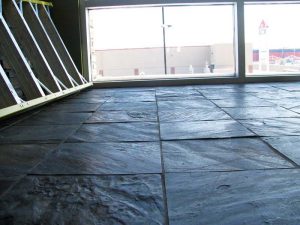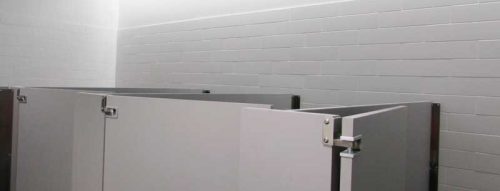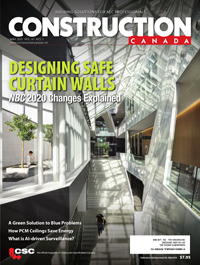Specifying Tile and Stone Concrete: How much lippage is too much?

Photo © Bigstock.com
Calculating allowable tile lippage
At the beginning of this article, the author stated allowable lippage is either 1 or 2 mm (1⁄32 or 1⁄16 in.), depending on the tile and the width of the grout joint, in additional to the inherent warpage of the tile manufactured in accordance with ANSI A137.1. Tile Council of North America (TCNA) interprets this in its 2014 Handbook for Ceramic, Glass, and Stone Tile Installation as meaning the inherent warpage of a particular tile is the actual warpage the specific tile has when installed.
Some people incorrectly interpret this to mean they can take the maximum allowable warpage stated in ANSI A137.1 and add it to the respective allowable lippage value. However, this author believes the calculated lippage would be unreasonable and excessive from a standard-of-care point of view for professional tile installations.
Installation methods
The tile installation method can help limit lippage or contribute to its excessiveness. Adhering the tile directly to the substrate, particularly when it has not been properly prepared to meet the industry requirements for flatness, can make it difficult to avoid lippage. On the other hand, installing tile in a fresh dry-pack mortar bed while it is still in a plastic stage can help compensate for dimensional variations because the installer can embed it into the fresh mortar.
Another contributing factor is the skill and craftsmanship by the tile installer. When workers are not sufficiently experienced, skilled, or detail-minded, their poor workmanship can cause or contribute to excessive tile lippage. It is important qualified, skilled installers who understand current industry standards are used for tile and stone installations to help ensure a successful installation.
Unavoidable lippage at drains
There are some applications where tile lippage to some degree is unavoidable. ANSI A108.02-2013 Section 4.3.7 cautions the lippage requirements do not apply to tiled floors sloping to drains specifically when using tiles that are 15 x 15 mm (6 x 6 in.) and larger. The larger the tile surface area, the greater the potential for tile lippage under these conditions. This is why one often sees tiles cut in half at a diagonal near drains with sudden changes in slope. However, this does not mean the installer can have extreme tile lippage—it still needs to be reasonable considering the conditions.
Using relatively new trench or linear drains for tile installations can be a good solution to avoiding this problem. The trench or lineal drains can be installed at the perimeters of decks or showers. The trench drains can be installed so the tile or stone is attached to the centre, enabling it to blend within the flooring, allowing drainage around the tile edges and avoiding lippage in these locations.

Conclusion
Not too long ago, this author was involved in an investigation in Grand Prairie, Alberta. The project was a medical office, where a large amount of natural stone had been installed as part of a remodeling effort. Although the stone had variations in thickness and surface texture, the installer did a sloppy and improper installation, resulting in excessive lippage that became a liability to the owners in terms of a tripping hazard to their clientele; it was also a major nuisance because of the medical carts and walkers that clanked along as they travelled across the floor.
The building owner sued for the installation to be replaced. This author’s firm wrote replacement installation guidelines to ensure the substrate surface was properly prepared to minimize variations in the surface; an installation method was also specified that would compensate for the variation in thickness of the stone.
Avoiding these problems is even better than fixing them, however. To do so, architects must write thorough detailed specifications that are specific, complete, and clear. Installers must be current with industry standards, and follow those standards and the manufacturers’ directions while installing the tile. Installers are mechanics with the skill level to provide quality workmanship, but they should not be expected to make architectural decisions—architects must give the installers the information and details they need to do their job correctly.
Most installers learn their skill on the job and do not have the opportunity to learn the industry standards. So it should be specified and verified that tile-installers are up to date with the current industry standards.
This author has never investigated a tile or stone failure and found all the industry standards and manufacturers’ instructions were followed. The problem is never due to one deficiency, but is always because of many compounding problems. Simply put, the key to a successful tile and stone installation is to follow industry standards and to write good specifications. MasterFormat and SectionFormat provide the structure for good-quality specifications, which, if used correctly and thoroughly, will limit both the designer’s (and the client’s) risk and liability when ceramic tile, glass tile, and stone applications are specified.
For more information on how to best specify, check out this author’s online article at
www.constructioncanada.net/specifying-lippage-with-MasterFormat.
| PERCEPTION IS REALITY? |
 Sometimes, the building owner will see excessive tile lippage despite everything being within allowable standard tolerances. Frequently, the culprit is lighting. Even the best of tile installations can look awry when the light is shining on the surface at a certain angle relative to the one from which it is being viewed. This is more problematic with large, rectangular tiles with narrow grout joints installed on walls, particularly in a staggered pattern. At certain angles and in the right sunlight, some tile exterior veneers look like there are built-in handholds to climb up the wall, despite lippage actually being within tolerance. This is because lighting causes shadowing at the grout joint, creating an optical illusion. (This can also occur in interior applications with daylighting or electrical systems.) TCNA’s Handbook for Ceramic, Glass, and Stone Tile Installation warns use of wall-washer and cover-type lighting—where lights are located either at the wall/ceiling interface or mounted directly on the wall—may produce shadows and undesirable effects with tiles. Similar shadows are created from side-lighting interior walls and floors when light shines from an angle through windows and doors. This author has investigated many commercial and residential projects where there were complaints of alleged excessive tile lippage only to find out during the inspection it was reasonable and within allowable industry tolerances. |
 Donato Pompo, CTC, CSI, CDT, MBA, is the founder of Ceramic Tile and Stone Consultants (CTaSC) and the University of Ceramic Tile and Stone (UofCTS). He has more than 35 years of experience in the ceramic tile and stone industry from installation to distribution to manufacturing of installation products. Pompo provides services in forensic investigations, quality control (QC) services for products and installation methods, training programs, testing, and onsite quality control inspection services. He can be reached at donato@ctasc.com.
Donato Pompo, CTC, CSI, CDT, MBA, is the founder of Ceramic Tile and Stone Consultants (CTaSC) and the University of Ceramic Tile and Stone (UofCTS). He has more than 35 years of experience in the ceramic tile and stone industry from installation to distribution to manufacturing of installation products. Pompo provides services in forensic investigations, quality control (QC) services for products and installation methods, training programs, testing, and onsite quality control inspection services. He can be reached at donato@ctasc.com.







